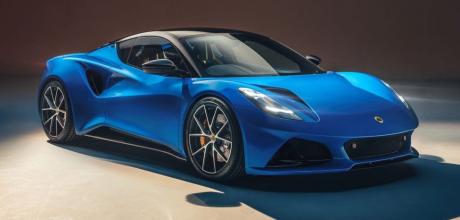New life at Hethel - £100m site investment leads to launch of Lotus’s final combustion-engined car
Change is afoot at Lotus, though the launch of the hugely impressive new Emira feels more like a major segue than the end of an era. It’s purely petrol-powered (no hybrids) and steers with hydraulic (rather than feel-killing electric) assistance, both of which will surely delight driving enthusiasts. And it’s still built in a big shed at Hethel, near Norwich, where Lotus production has mostly trickled along since 1966.
Yet those production processes have been tightened to suit big-league sports car customers, thanks to a £100m investment at the factory and the considerable backing and parts-sourcing expertise of Chinese parent company Geely. At a stroke, the number of cars built here will triple, from around 1600 of the old Elise, Exige and Evora trio (which die at the end of 2021; this is your last chance) to 4800 Emiras in 2022. The future of Lotus never looked so bright.
Not that the sun was shining as former F1 champ Jenson Button bounded out to talk about his privileged test run. Vast East Anglian skies heaved with thunder and torrential rain while reminders of Lotus’s past – from Elan to Exige via the glorious Type 72 racer – ran demo laps at the (newly resurfaced) Hethel test track, the 72’s rooster tail and DFV shriek proving particularly rousing.
Then the Type 131 Emira snarled its way round: Lotus’s first new car since 2008’s Evora, almost bang-on that car for dimensions but far less awkwardly proportioned, weighing a surprisingly portly minimum 1405kg and looking slick, professional, modern. Nothing radical, but tasteful, with clear nods both to the electric Evija hypercar and back to the Elise and Evora. Scoops and swages are there only to ensure excellent aero performance; the structure is a refinement of the extruded and bonded aluminium system born with the Elise.
‘Every panel has a part to play in airflow,’ said design chief Russell Carr. ‘We’ve packed the visual drama of a supercar into a usable, compact sports car.’
Carr echoed a sentiment suggested by Lotus MD Matt Windle: ‘It feels like we’ve achieved a junior supercar in a sports car package. This is the most accomplished road car to come out of the gate at Hethel.’That’s quite a promise, and appropriate for what Windle called Lotus’s ‘last hoorah for the internal combustion engine’.
Power (we’re told to expect 360-400bhp) comes from either the Evora’s brawny Toyota-sourced 3.5-litre supercharged V6 or, thanks to a tie-up between Geely and Daimler, AMG’s 2.0-litre turbo four. The latter will be available Only with twin-clutch paddleshift transmission, suggesting it will be the choice of trackday heroes, for whom a specific chassis setting will also be available. Those who favour road sensation over lap times will likely love the V6; the manual version features a semi-exposed shift mechanism. Performance claims are of 0-62mph in 4.5sec and 180mph flat out. We weren’t allowed to drive it but Button was. ‘It feels light, nimble and comfortable,’ he said, and spoke much of ‘mechanical grip’. On a video of his laps it certainly looked wonderfully supple over the kerbs – it’s a Lotus; we can expect the driving experience to be sublime. ‘Lotus should be proud of what they’ve achieved,’ he concluded.
Button also mentioned no fewer than four times how plush the interior is. And it’s certainly a step on: cubbies, cupholders, fine leather surfaces, TFT screens, flock-lined door pockets. Not a parts-bin special as such, though the window/mirror control cluster is straight from Geely partner Volvo. Finish-wise it’s on par with, say, a Jag XE, though it’s obviously cosier, and the raised centre console feels very Alpine. At an expected £60,000 it’s going straight into upper Porsche Cayman territory, a big test that the Emira looks far more likely to pass than the Evora did.
Time for a brief factory tour. As we left the new, glassy Heritage Centre, here and there Brazilian-pruned shrubbery was striving to disguise the screen walling and chainlink fencing of the site’s old airbase roots. But two new production halls represent a £100m investment in systems, process and staffing.
The workforce here has been doubled, and mention should be made of the company’s new tech centre at Wellesbourne, in the Midlands, close to Aston Martin’s Gaydon site, plus a new manufacturing facility in Norfolk. That £100m is small-change in the £1.5bn Geely started working through after taking over in 2017.
Within the new 12,000m2 halls are a handful of prototypes in various states of dress, each mounted on an ‘automated guided vehicle’ that carries the chassis to every workstation and which can be raised or lowered according to what access is required. As well as a state-of-the- art paint shop and an automated-measuring rig that uses lasers to check build precision, other new infrastructure includes a rolling road on which every car is tested before moving on to a rattle-test rig and then a ‘monsoon booth’ to test water-tightness. Finally, every car is blasted around the track.
So much is new here – but both Carr and Windle have been at Lotus for years. Chief aerodynamicist Richard Hall gets the final word: ‘The Emira represents the culmination of decades of experience to produce one of the greatest sports cars ever.’ Here’s hoping.
‘WE’VE PACKED THE VISUAL DRAMA OF A SUPERCAR INTO A USABLE, COMPACT SPORTS CAR’ RUSSELL CARR
Clockwise, from left - New Emira replaces Elise, Exige and Evora; Button was very taken with ‘plush’ interior; exterior echoes the junior supercar idiom; airbase originsobvious in 1991 aerial photo; new production halls are hugely impressive; it’s all a far cry from when Europas were on the line in 1966.


